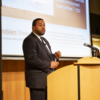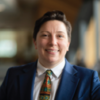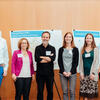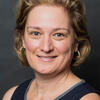Featured Research Center
Center for Sustainable Communities
The Center for Sustainable Communities (CSC) at Temple University conducts integrated social and environmental research on natural, technological, and socioeconomic systems to address the challenges of sustainability—how can we meet the needs of people locally and globally through equitable, innovative, and practical solutions that protect the environment which sustains life on the planet. Since its move to CLA in 2017 from the Tyler School of Art and Architecture where it was founded in 2000, CSC has been led by Director Melissa Gilbert, Professor of Geography, Environment and Urban Studies. According to Professor Gilbert, “CSC really tries to understand the challenges of sustainability and how we meet the needs locally and globally of both people and the environment in equitable ways.”
CSC conducts interdisciplinary and transdisciplinary research for sustainable development. The center draws on expertise from across the social and environmental sciences and diverse methodological approaches that include geospatial analysis and techniques, community-based research, and citizen science. “A unique feature of CSC is that, in addition to bringing together the natural/physical scientists with social scientists and humanities folks, we also have a lot of expertise in community-based research, citizen science, policy analysis, and geospatial analysis. These are key methodological areas we can bring to be bear on sustainable cities, health and wellbeing, reducing inequality, and promoting decent work, such as green jobs. We’re able to bring together people from different perspectives because sustainability issues are so complex one person or discipline cannot solve them.”
CSC is focused on the next frontier of research for understanding and anticipating pressing sustainability challenges as well as for facilitating the contribution of social science and academia to enabling societal transitions toward sustainability. “CSC acts as a convener,” Professor Gilbert notes. “We bring together people from across the university who are interested in sustainability research and education. Our focus has been on developing long-term relationships with policymakers and community members locally but also around the world. It’s exciting to be able to bring people together to perform more solutions-oriented research.”
As the effects of climate change become increasingly salient and more people tune in to the importance of sustainability, Professor Gilbert hopes CSC continues to be at the forefront of these conversations. “In order address challenges of climate change and the ways it is affecting marginalized communities, we need to understand the issue from multiple disciplinary perspectives, but scholars also need to work with the people most affected to come up with their research questions and solutions. I hope that CSC continues to build networks of researchers such as faculty, graduate students, undergraduates, policymakers, and community members to expand this work and be part of a just transition to a more sustainable future.”
Visit the website to learn more about CSC and to get involved with the center.
Accolade Highlights
- Jeffrey Ward (Criminal Justice) has received continuation funding from UCLA (Arnold Ventures) for the project “Second Chances: A National Outcomes Study of Safe and Equitable Decarceration Among People Serving Juvenile Life Without the Possibility of Parole.”
- For the project “Exploring the Tipping Point from Political Discourse to Electoral Terrorism," Steven Windisch (Criminal Justice) has received continuation funding from the University of Central Florida (Department of Homeland Security).
- Caterina Roman (Criminal Justice) has received continuation funding from RTI International for the project “Witness Intimidation and the Government's Response.”
- Tania Giovannetti (Psychology and Neuroscience) has received continuation funding from the University of Pennsylvania (PA Department of Health) for the “Aging Brain Cohort Dedicated to Diversity Study.”
- Jerry Ratcliffe (Criminal Justice) has received continuation funding from the Department of Justice for the project “An Evaluation of the SEPTA Police SAVE Initiative.”
Announcements
Upcoming Events
Research Resources Day is coming to the Health Sciences Campus. The Office of the Vice President for Research (OVPR), Temple Libraries, and Temple ITS are hosting an in-person event for all faculty, staff and grants administrators who work on and conduct research at Temple on Wednesday, April 17, 2024, 1 to 3 p.m., in the lobby of the Medical Education and Research Building (MERB, 3500 N. Broad St.). Light refreshments will be provided. Register here.
Increase in Animal Per Diem Rates: FY25–FY27
Temple University is committed to managing its animal care and use program in an efficient manner, which includes a periodic review of animal per diem rates. Updated per diem rates will be charged for each day that a cage or animal (USDA species only) is housed within a ULAR managed space as of July 1, 2024. These rates will not be pro-rated.
Per diem rates will continue to be reviewed on a regular schedule and will be adjusted to account for inflation and/or other operational needs. This is an approach followed by most research institutions.
You can review existing and updates rates here. Please note that the new rates will apply to existing grants as well as new grant submissions.
Should you have questions regarding the new rates or the invoicing process, please contact Joanne Drew (joanne.drew@temple.edu). For any non-invoice related questions and clarifications, contact Dr. Dorian Culmer-Butler (dorian.culmer-butler@temple.edu).
Sampling of External Funding Opportunities
Collaborative Grant in China Studies
LUCE/ACLS
Due: June 13, 2024
Optional LOI: April 17, 2024
W.E.B. Du Bois Program of Research on Reducing Racial and Ethnic Disparities in the Justice System
National Institute of Justice
Due: May 30, 2024
Research and Development Grants
National Endowment for the Humanities
Due: May 21, 2024
Optional Draft Due: April 9, 2024
Research Grants on Education (Small)
Spencer Foundation
Due: April 30, 2024
Core Research Grants (Core Programs and Special Initiatives)
Russell Sage Foundation
LOI Due: April 16, 2024
Promoting Educational Attainment and Economic Mobility among Racially, Ethnically, and Economically Diverse Groups after the 2023 Supreme Court Decision to Ban Race-Conscious Admissions at Colleges and Universities
Russell Sage Foundation, in collaboration with the Hewlett, Spencer, and William T. Grant Foundations
Due: April 16, 2024







